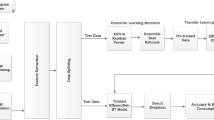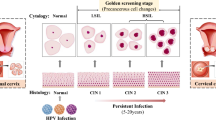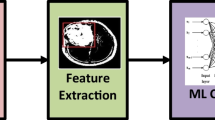Abstract
Cervical dysplasia is a cancerous condition, and it is essential to correctly identify them from Pap smear images using machine intelligence. Regular screening and early diagnosis is the most vital step for detecting dysplastic stage, so as to treat them effectively. However, the manual inspection of Papanicolaou test screened under microscope is laborious, subjective and time-consuming task. Therefore, the objective of this research was to develop an artificial intelligence-enabled assistive tool to detect the cervical dysplasia cancer. Here, the pixel-based segmentation to classification mapping approach is introduced which is the two-step classification, i.e. cell segmentation and cell classification. In cell segmentation stage, the novel filter to feature map approach is used. Total 112 filtered images were generated from each original cell images. The feature vector was then created for every original pixel using filtered images. In Dysplasia cancer classification stage, the 163 features consisting the edge detector, texture, noise, membrane detector and colour features are considered. Three classifiers, namely artificial neural network (ANN), support vector machine (SVM) and random forest (RF), are used to detect and diagnose the dysplasia stage cancer. These classifiers are evaluated for performance using seven different performance measures. For cell segmentation approach, the RF reported accuracy of 99.07% and it outperformed in terms of accuracy over ANN and SVM classifiers. Finally, the cervical dysplasia is accurately identified with 97.5% accuracy using ANN as compared to SVM and RF.





Similar content being viewed by others
References
Alyafeai, Z., Ghouti, L.: A fully-automated deep learning pipeline for cervical cancer classification. Expert Syst. Appl. 141, 112951 (2020)
Vu, M., Yu, J., Awolude, O.A., Chuang, L.: Cervical cancer worldwide. Curr. Probl. Cancer 42(5), 457–465 (2018)
Anantharaman, V.V., Sudharshini, S., Chitra, A.: A cross-sectional study on knowledge, attitude, and practice on cervical cancer and screening among female health care providers of Chennai corporation, 2013. J. Acad. Med. Sci. 2(4), 124 (2012)
Arbyn, M., Weiderpass, E., Bruni, L., de Sanjosé, S., Saraiya, M., Ferlay, J., Bray, F.: Estimates of incidence and mortality of cervical cancer in 2018: a worldwide analysis. Lancet Glob. Health 8(2), e191–e203 (2020)
Siegel, R., Naishadham, D., Jemal, A.: Cancer statistics, 2012. CA Cancer J. Clin. 62(1), 10–29 (2012)
I. A. for Research on Cancer. Population fact sheets India. Global Cancer Observatory (2018). [Online]. http://gco.iarc.fr/today/data/factsheets/populations/356-india-fact-sheets.pdf
Mittra, I., Mishra, G.A., Singh, S., Aranke, S., Notani, P., Badwe, R., Miller, A.B., Daniel, E.E., Gupta, S., Uplap, P., et al.: A cluster randomized, controlled trial of breast and cervix cancer screening in Mumbai, India: methodology and interim results after three rounds of screening. Int. J. Cancer 126(4), 976–984 (2010)
Thulaseedharan, J.V., Malila, N., Hakama, M., Esmy, P.O., Cheriyan, M., Swaminathan, R., Muwonge, R., Sankaranarayanan, R.: Socio demographic and reproductive risk factors for cervical cancer—a large prospective cohort study from rural India. Asian Pac. J. Cancer Prevent. 13(6), 2991–2995 (2012)
Song, Y., Tan, E.-L., Jiang, X., Cheng, J.-Z., Ni, D., Chen, S., Lei, B., Wang, T.: Accurate cervical cell segmentation from overlapping clumps in pap smear images. IEEE Trans. Med. Imaging 36(1), 288–300 (2016)
Juneja, A., Sehgal, A., Mitra, A., Pandey, A.: A survey on risk factors associated with cervical cancer. Indian J. Cancer 40(1), 15–22 (2003)
Cervical Cancer Overview. National Cervical Cancer Coalition (2020). [Online]. https://www.nccc-online.org/hpvcervical-cancer/cervical-cancer-overview/
de Sanjosé, S., Alemany, L.: HPV and cancer: epidemiology and mechanism of carcinogenesis of the virus HPV. In: Tropical Hemato-Oncology, pp. 143–156. Springer (2015)
SY, Tan, Y., Tatsumura.: “George papanicolaou (1883–1962): discoverer of the pap smear,” Singapore Medical Journal, vol. 56, no. 10, p. 586–587, (2015)
Jantzen, J., Dounias, G.: Pap smear DTU/HERLEV databases. http://mde-lab.aegean.gr/index.php/downloads. Accessed 21 Dec 2019
Jantzen, J., Norup, J., Dounias, G., Bjerregaard, B.: Pap-smear benchmark data for pattern classification. In: Nature inspired Smart Information Systems (NiSIS 2005), pp. 1–9 (2005)
Teeyapan, K., Theera-Umpon, N., Auephanwiriyakul, S. Application of support vector based methods for cervical cancer cell classification. In: IEEE International Conference on Control System, Computing and Engineering (ICCSCE), pp. 514–519. IEEE (2015)
Phoulady, H.A., Zhou, M., Goldgof, D.B., Hall, L.O., Mouton, P.R.: Automatic quantification and classification of cervical cancer via adaptive nucleus shape modeling. In: 2016 IEEE International Conference on Image Processing (ICIP), pp. 2658–2662. IEEE (2016)
GençTav, A., Aksoy, S., ÖNder, S.: Unsupervised segmentation and classification of cervical cell images. Pattern Recogn. 45(12), 4151–4168 (2012)
Bora, K., Chowdhury, M., Mahanta, L.B., Kundu, M.K., Das, A.K.: Automated classification of pap smear images to detect cervical dysplasia. Comput. Methods Programs Biomed. 138, 31–47 (2017)
Solar, M., Gonzalez, J.P.P.: Computational detection of cervical uterine cancer. In: 2019 Sixth International Conference on eDemocracy & eGovernment (ICEDEG), pp. 213–217. IEEE (2019)
Devi, M.A., Sheeba, J., Joseph, K.S.: Neutrosophic graph cut-based segmentation scheme for efficient cervical cancer detection. J. King Saud Univ. Comput. Inf. Sci. 34(1), 1352–1360 (2018)
Ashok, B., Aruna, P.: Comparison of feature selection methods for diagnosis of cervical cancer using SVM classifier. Int. J. Eng. Res. Appl. 6, 94–99 (2016)
William, W., Ware, A., Basaza-Ejiri, A.H., Obungoloch, J.: Cervical cancer classification from pap-smears using an enhanced fuzzy c-means algorithm. Inf. Med. Unlocked 14, 23–33 (2019)
Guven, M., Cengizler, C.: Data cluster analysis-based classification of overlapping nuclei in pap smear samples. Biomed. Eng. Online 13(1), 159 (2014)
Cloppet, F., Boucher, A.: Segmentation of overlapping/aggregating nuclei cells in biological images. In: 2008 19th International Conference on Pattern Recognition, pp. 1–4. IEEE (2008)
Zhang, L., Lu, L., Nogues, I., Summers, R.M., Liu, S., Yao, J.: Deeppap: deep convolutional networks for cervical cell classification. IEEE J. Biomed. Health Inf. 21(6), 633–1643 (2017)
Paul, P.R., Bhowmik, M. K., Bhattacharjee, D.: Automated cervical cancer detection using pap smear images. In: Proceedings of Fourth International Conference on Soft Computing for Problem Solving, pp. 267–278 (2015)
Song, Y., Zhang, L., Chen, S., Ni, D., Li, B., Zhou, Y., Lei, B., Wang, T. A deep learning based framework for accurate segmentation of cervical cytoplasm and nuclei. In: 36th Annual International Conference of the IEEE Engineering in Medicine and Biology Society, pp. 2903–2906. IEEE (2014)
Hemalatha, K., Rani, K.U.: Feature extraction of cervical pap smear images using fuzzy edge detection method. In: Data Engineering and Intelligent Computing, pp. 83–90. Springer (2018)
Mulmule, P.V., Kanphade, R.D.: Classification of overlapping cells in microscopic cervical images: a transfer learning approach. In: 2021 Asian Conference on Innovation in Technology (ASIANCON), pp. 1–7. IEEE (2021)
Lakshmi, G.A., Ravi, S.: A double layered segmentation algorithm for cervical cell images based on GHFCM and ABC. Int. J. Image Graph. Signal Process. 9(11), 39–47 (2017)
Sajeena, T., Jereesh, A.: Automated cervical cancer detection through RGVF segmentation and SVM classification. In: 2015 International Conference on Computing and Network Communications (CoCoNet), pp. 663–669. IEEE (2015)
Bhatt, A.R., Ganatra, A., Kotecha, K.: Cervical cancer detection in pap smear whole slide images using convnet with transfer learning and progressive resizing. PeerJ Comput. Sci. 7, e348 (2021)
Lu, Z., Carneiro, G., Bradley, A.P., Ushizima, D., Nosrati, M.S., Bianchi, A.G.C., Carneiro, C.M., Hamarneh, G.: Real cervical cytology images databases. https://cs.adelaide.edu.au/carneiro/isbi14-challenge/dataset.html. Accessed 29 Dec 2019
Lin, H., Hu, Y., Chen, S., Yao, J., Zhang, L.: Fine-grained classification of cervical cells using morphological and appearance based convolutional neural networks. IEEE Access 7, 71541–71549 (2019)
Arganda-Carreras, I., Kaynig, V., Rueden, C., Eliceiri, K.W., Schindelin, J., Cardona, A., Sebastian Seung, H.: Trainable Weka segmentation: a machine learning tool for microscopy pixel classification. Bioinformatics 33(15), 2424–2426 (2017)
Rafael, C. G., Richard, E. W., Steven, L. E., Woods, R., Eddins, S.: Digital Image Processing using MATLAB. Tata McGraw-Hill (2010)
Burger, W., Burge, M.J., Burge, M.J., Burge, M.J.: Principles of Digital Image Processing, vol. 111. Springer, New York (2009)
Alpaydin, E.: Introduction to Machine Learning. MIT Press, Cambridge (2009)
Hill, T., Marquez, L., O’Connor, M., Remus, W.: Artificial neural network models for forecasting and decision making. Int. J. Forecast. 10(1), 5–15 (1994)
Noble, W.S.: What is a support vector machine? Nat. Biotechnol. 24(12), 1565–1567 (2006)
Livingston, F.: Implementation of Breiman’s random forest machine learning algorithm. In: ECE591Q Machine Learning Journal Paper, pp. 1–13 (2005)
Wu, M., Yan, C., Liu, H., Liu, Q., Yin, Y.: Automatic classification of cervical cancer from cytological images by using convolutional neural network. Biosci. Rep. 38(6), 1–9 (2018)
Arya, M., Mittal, N., Singh, G.: Three segmentation techniques to predict the dysplasia in cervical cells in the presence of debris. In: Multimedia Tools and Applications, pp. 1–16 (2020)
Marinakis, Y., Dounias, G., Jantzen, J.: Pap smear diagnosis using a hybrid intelligent scheme focusing on genetic algorithm based feature selection and nearest neighbor classification. Comput. Biol. Med. 39(1), 69–78 (2009)
Author information
Authors and Affiliations
Corresponding author
Ethics declarations
Conflict of interest
The authors declare that they have no conflict of interest.
Additional information
Publisher's Note
Springer Nature remains neutral with regard to jurisdictional claims in published maps and institutional affiliations.
Rights and permissions
About this article
Cite this article
Mulmule, P.V., Kanphade, R.D. & Dhane, D.M. Artificial intelligence-assisted cervical dysplasia detection using papanicolaou smear images. Vis Comput 39, 2381–2392 (2023). https://doi.org/10.1007/s00371-022-02463-9
Accepted:
Published:
Issue Date:
DOI: https://doi.org/10.1007/s00371-022-02463-9




